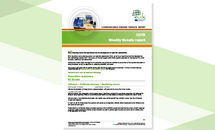Communicable disease threats, 5-11 August 2012, week 32
The ECDC communicable disease threats report is a weekly bulletin intended for epidemiologists and health professionals in the area of communicable disease prevention and control. Summarising information gathered by ECDC through its epidemic intelligence activities regarding communicable disease threats of concern to the European Union, it also provides updates on the global situation and changes in the epidemiology of communicable diseases with potential to affect Europe, including diseases that are the focus of eradication efforts.
Executive Summary
During the 2012 transmission season of the West Nile virus in Europe, Greece has reported 44 autochthonous cases (24 confirmed, 20 probable). Likewise, Italy notified ECDC about an asymptomatic case of West Nile virus infection in a resident of Venezia province. On 13 July, ECDC updated its Rapid risk assessment on West Nile virus infection in the European Union, which concluded that more cases should be expected.
Six autochthonous cases of Plasmodium vivax malaria have been reported from Greece since June 2012. According to the Greek authorities, active screening of neighbours and seasonal immigrants is being carried out to detect malarial infection, and vector control measures are being implemented.
Since July 2012, 152 cases of the variant influenza A(H3N2) virus (A(H3N2)v) have been detected in the US. No human-to-human transmission has been determined among these recent cases. These reports come following detection of 13 isolates with influenza A(H3N2)v in the US between August 2011 and April 2012. The recent increase in the number of cases is consistent with the conclusions of the ECDC risk assessment published in November 2011 and updated in December 2011.
Download





